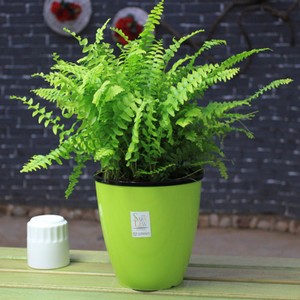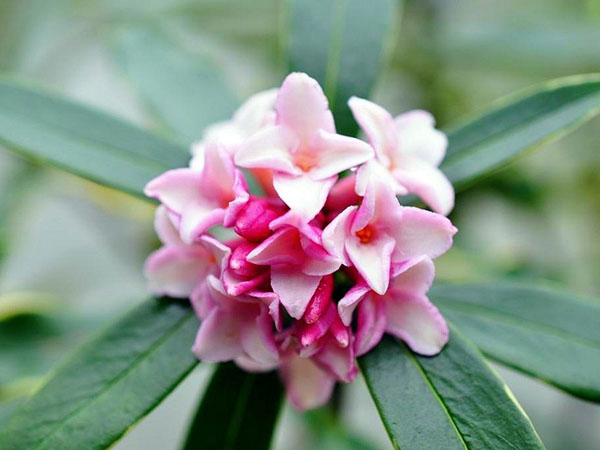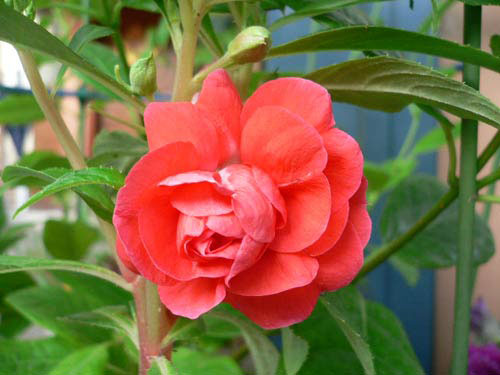Culture methods and precautions of Boston fern pictures of Boston fern
Boston fern is a terrestrial fern foliage plant of Nephropteridaceae and Pteridaceae. Native to the tropics and subtropics, it is distributed in Taiwan Province of China. It belongs to perennial evergreen fern herbs. Rhizome erect, stoloniferous. The leaves are tufted, up to 60 cm long, with slender compound leaves, the leaves spread and droop, the leaves are bipinnately parted, and the pinnae are auriculate at the base. The sporangium is semicircular, born on the back of the leaf near the edge of the leaf. This plant is a kind of drooping fern foliage plant, which is suitable for potted indoor hanging and ornamental, and its stolon cutting can be used as a decorative material. Boston fern, I believe many friends who don't know much about flowers have heard of it for the first time, but in fact, this plant is a more popular indoor potted plant. Now in the home life, the plant potted plant is a very common plant decoration, so the small potted Boston fern gradually appeared in people's life. So what exactly is this Boston fern and how to raise it? Today we're going to take a look at Boston ferns.

Culture methods and precautions of Boston fern pictures of Boston fern
Boston fern, perennial evergreen fern herbs of the genus Nephropteridaceae. Native to the tropics and subtropics, it is a drooping fern foliage plant, which is widely distributed in Taiwan Province of China. Boston fern, as a drooping foliage plant, is of high ornamental value, and is often hung indoors by potted plants, and stolons will also be cut off as decorative materials, so it is still common in people's lives. In addition, it is understood that Boston fern has a good ability to purify the air. When decorating the interior, it can effectively absorb formaldehyde in the air. It is recognized as the most effective biological purifier, which can absorb about 20 micrograms of formaldehyde per hour, so it is still very popular.
At present, there are not many breeding methods for Boston fern, because this plant is relatively unique, it will not produce spore leaves, so to a certain extent, it can only be propagated by ramet or walking stems. and the common method used by people is split propagation. When breeding, it is generally chosen every summer to cut off the small plants with roots from the stolon branches on the strong and vigorous Boston fern plants, plant them as cuttings in flowerpots, pour water and place them in a cool place indoors, and soon the plants will take root and sprout.
1. Soil management
As a good foliage plant, Boston ferns are often cultivated in pots, so how to raise Boston ferns? The first thing we need to pay attention to is the soil problem. Boston fern has higher requirements for soil, and pot culture needs to be mixed with rotten leaf soil, river sand and garden soil in proportion. The soil fertility should be sufficient, loose and breathable, and the drainage capacity is good. If there are conditions, you can also increase the amount of water moss in the soil, so that the soil is more perfect and Boston ferns can grow healthier. In addition, the potted soil needs to be changed every spring in order to maintain sufficient nutrients.
2. Lighting management
Boston fern likes light and warmth, so it is necessary to pay close attention to its light and temperature in the process of breeding. Although plants like light, Boston fern is still more suitable for semi-shady environment, try to avoid direct sunlight when breeding, otherwise its leaves will gradually wither and curl, under the care of scattering is the best.
3. Temperature management
The suitable temperature for the growth of Boston fern is between 18 and 35 degrees Celsius. Too high or too low temperature is disadvantageous to plant growth, especially when the temperature is above 35 degrees Celsius or below 15 degrees Celsius. And Boston fern is not cold-resistant, when the winter temperature is lower than 5 degrees Celsius, plants will appear the risk of frost injury, we should pay attention to control the plant growth temperature, appropriate cooling and warmth.
3. Water and fertilizer management
Boston fern does not have a particularly high demand for water and fertilizer. In terms of watering, proper water is fine, neither too much nor too little. When the soil is moist, plants can grow normally and healthily. If there is no water supplement for a long time, Boston ferns are prone to withering and falling leaves. In addition, in terms of fertilization, Boston fern needs to apply thin rotten cake fertilizer every 4 weeks during its growth. When fertilizing, you must be careful not to let the fertilizer stain the leaves of Boston fern, otherwise the leaves will be damaged.
How to breed Boston ferns? Culture methods and matters needing attention of Boston fern
Culture methods and matters needing attention of Boston fern
1. Lighting
Boston fern likes bright scattered light, it is appropriate to put it indoors with bright scattered light in spring and summer, when the sun is strong, the leaves will turn yellow, and the leaves will turn yellow when the sun is direct. In winter, the light should be increased appropriately, otherwise the leaf color will turn yellow or cause the leaf edge to dry up.
2. Moisture
Boston ferns like humid environments and require high soil and air humidity. Because the roots of Boston fern are adventitious roots, the ability to absorb and retain water is poor, so water must be supplied in time, otherwise drying for too long will easily lead to withered and yellow leaves. The basin soil in spring and summer should always remain moist, but it should not be too wet. It is better to keep the basin soil moist frequently. Besides timely watering, it is also necessary to spray water to the foliar surface in summer. When the room temperature is low in winter, you should reduce watering and keep the soil slightly moist.
3. Fertilization
The fertilization concentration of Boston fern should not be too high, otherwise it is easy to hurt the roots. the best way of fertilization is to add rotten barnyard manure first when filling the pot (changing the basin every other year in spring), and then topdressing with thin fertilizer in the peak growing season. When applying fertilizer, it is necessary to avoid contamination of the leaves. If it is accidentally contaminated, it should be washed with clean water immediately.
4. Temperature
The suitable temperature for the growth of Boston fern is 15-25 ℃, and it can survive the winter safely when it is above 10 ℃ in winter.
How to raise Boston fern culture methods and matters needing attention
Boston fern is an evergreen fern plant, suitable for indoor viewing, its stolon cut can be used as a decorative configuration material, is a very good household pot plant. How do you raise Boston ferns? Let's learn about the breeding methods and points for attention of Boston fern.
1. How to raise Boston fern
Generally placed in the indoor bright scattered light training, can not be exposed to direct light, but also can not be cultured in the dark. The suitable temperature for growth is 15-25 ℃, and it can survive the winter safely when it is above 10 ℃ in winter.
Although drought-resistant, but still need sufficient water, and should not be too wet or too dry, to keep the basin soil often moist. In summer, water is watered once or twice a day, often spraying water to the leaves. Do not need much fertilizer, the growth period every 4 weeks to apply thin rotten cooked cake fertilizer, should not use quick-acting chemical fertilizer, fertilization must not stain the leaves, so as to avoid damage. The mixed culture soil of rotten leaf soil, river sand and garden soil was selected in pot culture, and the growth was better when water moss was used as culture medium. Change the basin every other year in the spring.
Second, the culture method of Boston fern.
1, lighting: Boston fern likes bright scattered light, it is appropriate to put it indoors with bright scattered light in spring and summer, when the sun is strong, it can not be placed in direct sunlight, when the sun is direct, the leaves will turn yellow; in winter, the light should be increased appropriately, otherwise the leaf color is easy to turn yellow or lead to leaf edge drying.
2. Moisture: Boston fern likes humid environment and requires higher soil moisture and air humidity. Because the roots of Boston fern are adventitious roots, the ability to absorb and retain water is poor, so water must be supplied in time, otherwise drying for too long will easily lead to withered and yellow leaves. The basin soil in spring and summer should always remain moist, but it should not be too wet. It is better to keep the basin soil moist frequently. Besides timely watering, it is also necessary to spray water to the foliar surface in summer. When the room temperature is low in winter, you should reduce watering and keep the soil slightly moist.
3. Fertilization: the fertilization concentration of Boston fern should not be too high, otherwise it is easy to hurt the roots. the best way of fertilization is to add rotten barnyard manure first when loading the pot (changing the basin every other year in spring), and then topdressing with thin fertilizer in the peak growing season. When applying fertilizer, it is necessary to avoid contamination of the leaves. If it is accidentally contaminated, it should be washed with clean water immediately.
4. Temperature: the suitable temperature for the growth of Boston fern is 15-25 ℃, and it can survive the winter safely above 10 ℃ in winter.
5. Soil: when selecting soil, Boston fern should choose the mixed culture soil of rotten leaf soil, river sand and garden soil. Under certain conditions, the water moss can be used as the medium to grow better, and the Boston fern has to change the basin once a year. When Boston fern is cultivated outdoors, about half of the expanded plastic artificial soil can be mixed into the ordinary culture soil and mix well.
6. Fertilization: Boston fern does not need much fertilizer. Thin rotten cake fertilizer can be applied every 4 weeks during the growing period. Boston fern should not use quick-acting chemical fertilizer. Do not stain Boston fern leaves when fertilizing, so as not to damage Boston fern.
7. Diseases and insect pests: Boston fern diseases are mainly leaf spot disease and quenching disease, and insect pests are mainly caused by caterpillars, shell insects, pink scale, nematodes and so on.
Matters needing attention in Boston fern culture
1. During the growing period, Boston fern should be watered once a day, and drip irrigation should be applied to prevent the leaves of Boston fern from becoming withered and rotten. Hot summer can also spray water around Boston ferns to increase humidity.
2. If the Boston fern is too dry, the edge of the leaf will be withered and yellow, and even the whole leaf of Boston fern will be withered and yellow. At noon in summer, shading and ventilation should be strengthened to supplement Boston fern leaf water and surface water to achieve the purpose of cooling.
3. Boston fern, like warm semi-shady environment, suitable for scattered light, can not let direct sunlight, otherwise Boston fern is easy to wilt and curl.
4. in order to ensure the beautiful plant shape of Boston fern and promote air circulation, the withered and yellow leaves of Boston fern should be cut off combined with plastic surgery.
The above is the introduction of the breeding method of Boston fern. Friends who like Boston fern can see if their breeding is reasonable.
- Prev

The culture method of Daphne odorifera
Daphne also known as: sleeping incense, Penglai purple, amorous tree, dew nail, white Ruixiang, Qianlixiang, Ruilan, snow skin, cotton skin. Originally produced in Huiyuan Rock, Wuyishan City, Fujian Province, it has been cultivated for more than 100 years. Mainly distributed in the inner mountains of Wuyi Mountain (Yanshan). Since the 1980s
- Next

The planting method of Camellia Impatiens pictures of Camellia Impatiens
Friends who like flowers and plants must like camellia impatiens, but do not misunderstand that it is a kind of camellia, because it is a plant of the family Impatiens family, because it is a large double flower, and its flowers are colorful like camellias. many people who grow it say that it is difficult to raise impatiens.
Related
- Fuxing push coffee new agricultural production and marketing class: lack of small-scale processing plants
- Jujube rice field leisure farm deep ploughing Yilan for five years to create a space for organic food and play
- Nongyu Farm-A trial of organic papaya for brave women with advanced technology
- Four points for attention in the prevention and control of diseases and insect pests of edible fungi
- How to add nutrient solution to Edible Fungi
- Is there any good way to control edible fungus mites?
- Open Inoculation Technology of Edible Fungi
- Is there any clever way to use fertilizer for edible fungus in winter?
- What agents are used to kill the pathogens of edible fungi in the mushroom shed?
- Rapid drying of Edible Fungi

